As we’re tracking the histories associated with the tablets that were installed in 1886 to commemorate the bicentennial of Albany’s charter as a city, we’ve been lucky so far in that nearly all of the tablets we’ve written about have survived. The first lost tablet marked the site of the first Lutheran Church. Now the second one that has been lost is the one marking the site of the first Presbyterian church. And given the tremendous changes in topography in this particular part of Albany, it’s a little difficult to show exactly where it was. But we’ll try.
Tablet No. 9—First Presbyterian Church
Bronze tablet, 16×22 inches, inserted in the wall of building north-east corner of Grand and Hudson streets. Inscribed thereon :
“Site of the First Presbyterian Church — Built 1763 — Removed 1796.”
Of course the north-east corner of Grand and Hudson doesn’t exist anymore, it’s buried somewhere under what is now the Times-Union Center. And to the best of my knowledge this tablet doesn’t exist anymore either. The Argus in 1914 noted that this was one of three tablets that had “been refastened with slot-headed screws, instead of having the heads filed flat as originally, and in one case at least the screws are becoming loosened.” The paper also noted that “there is a possibility of the city taking the block bounded by Hudson avenue, Grand, Beaver and William streets for an addition to the public market, in which case something would have to be done with tablet No. 9, marking the site of the First Presbyterian church.” In the end, that building was unaffected by the market, which was built across the street.
The Neighborhood
It is really hard to relate where things used to be when they have changed so very, very substantially. All of our tablets so far have been on buildings that continue to exist, or at least in places we could point to with some ease. But here we’re talking about entire city blocks that don’t exist anymore, on streets that we barely recognize in the modern landscape. So we’ve done the best we can to relate where the first three buildings of the First Presbyterian Church of Albany were located, on the map below. The first location is squarely underneath the Times-Union Center (not to worry: the Presbyterians came late enough there were no burials around their church that we are aware of). The second is under the plaza corner of the Omni Tower. The third is buried directly below the egress roads from the Empire State Plaza and the East Parking Garage.
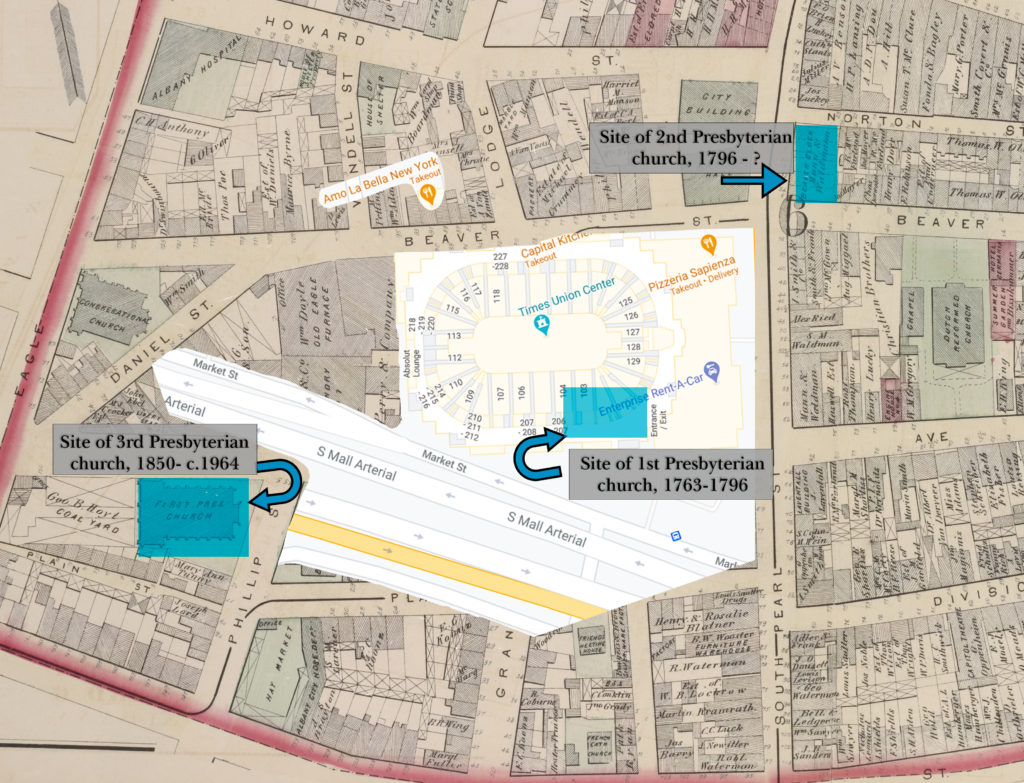
The First Presbyterian Church
A history of the First Presbyterian Church of Albany, written by Rev. J. McClusky Blayney in 1877, relates the early history of religion in Albany that we have already covered in talking about the first Dutch church, the first Lutheran church, and the first English church. Then it unhelpfully says, “The exact date and circumstances of the organization of the Presbyterian Church in this city, I have not been able to ascertain.” We aren’t a professional historian, but to Mr. Blayney, author of the history of the First Presbyterian Church, we must say: you had one job.
Blayney said that he had seen published notices of the date of organization of the church as 1763, and that he thought it a mistake related to the deed of October 1763, when the City provided a deed for a lot on which to build a church. Blayney believed the congregation dated to at least a year earlier, in 1762, and he noted that in 1760 there was at least Presbyterian preaching being done here. The Albany church was associated with the Dutchess County Presbytery in late 1762 or 1763. In 1775 it was transferred to the Presbytery of New York; a Presbytery of Albany was established in 1790. The first pastor of this church was Rev. William Hanna. But the Bicentennial Committee, anyway, was satisfied with a date of 1763 for the church building, and that appears to be the best we’re going to do.
The first church building: Hudson and Grand
The first building stood with Hudson street to its south, Grand to its west, Beaver to the north, and William to the east. Blayney writes that “This ground was then known as ‘the gallows hill,’ and is described as being ‘very steep.'” (Several Albany locations have been called gallows hill at various times.)
“The first church building was erected on this lot during the year 1764. A stairway winding around the hill, and very difficult of ascent during the winter season, was the only means of approach to the church. The house was built of wood, and is described as being ‘of a respectable size, though not of a very elegant appearance.’ It was covered with a flat roof and surmounted with a tower and spire, the tower containing a bell. it was painted red, and stood fronting the east.” Unfortunately, we have found no image of this first church. This description is as much as we know of it.
That description would place the very first Presbyterian church building just about at the southeast box office entrance of the Times-Union Center (or the Knickerbocker Arena, as some of us oldsters insist on still calling it). The driveway into the parking lot from the current Market Street (no relation to the older Market Street, which was on the other side of the expressway) is essentially William Street. The marker was placed on a building at the northeast corner of Grand and Hudson, so just a little bit west along the Times-Union Center’s current structure from that entrance. The building that stood there (97 Hudson, or 16 Grand, depending on which way one was facing) was used for many years by Chuckrow’s Poultry – possibly as early as 1900, and at least until 1972. So it appears the building even survived the Empire State Plaza and expressway construction.
A look at photographs of Chuckrow’s doesn’t reveal the location of the tablet – given how many windows were in the facade at street level, it’s likely that renovations to the building could have displaced the tablet at any time. The building likely survived into the ’70s; a 1980s photograph shows the corner building gone but the remaining strip on Grand still intact, so the block likely survived until the construction of the Albany County Civic Center project that became known as the Knickerbocker, currently the Times-Union Center.
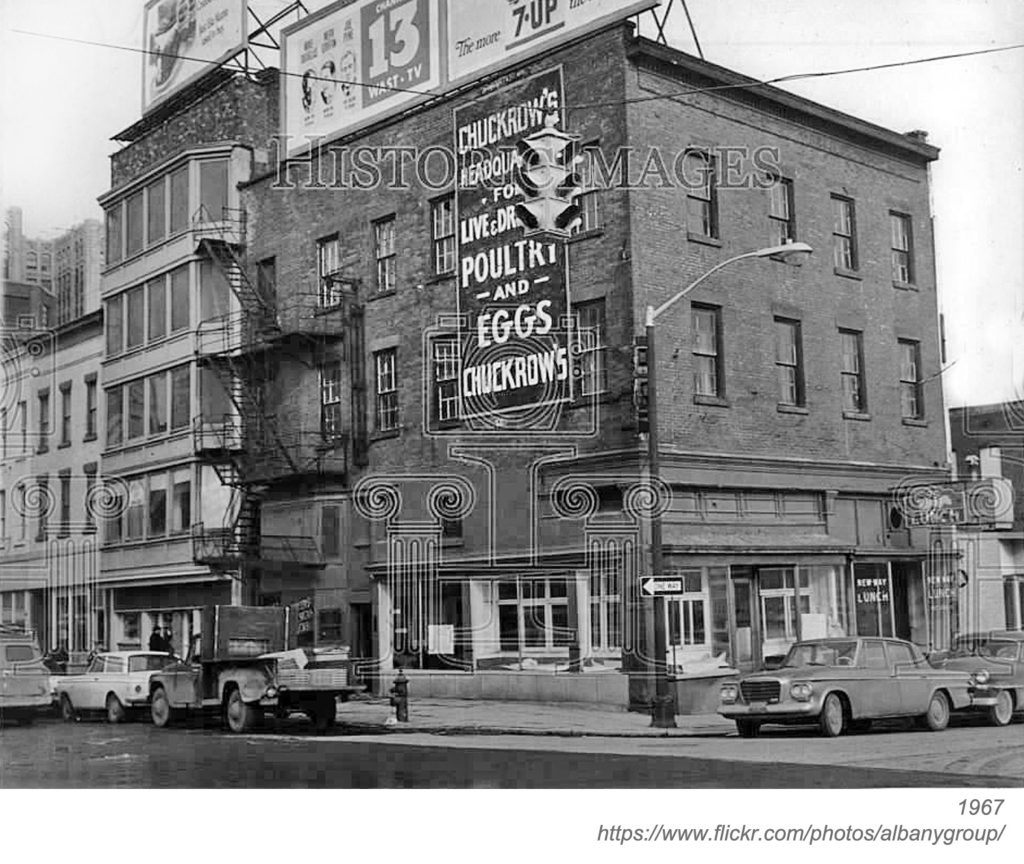
The second church building: South Pearl and Beaver
Owing to the growth in the congregation, the trustees of the church appointed a committee in 1792 to purchase “a lot on the plains” for a new church – presumably they had had enough of the stairs. The lot was on the northeast corner of South Pearl and Beaver streets, and a construction contract was let in March 1795. They struggled to raise the needed money, and borrowed against the future sale of pews. The church was completed and first occupied Nov. 2, 1796; “the steeple was not finished for nearly twelve years afterwards.”
Given the timing, we suspected that this second church could have been the work of Albany’s preeminent architect of the day, Philip Hooker, but according to “A Neat Modern Stile: Philip Hooker and His Contemporaries,” this design was by Elisha Putnam. The steeple that wasn’t finished for nearly twelve years, however, was credited to Philip Hooker, in 1808.
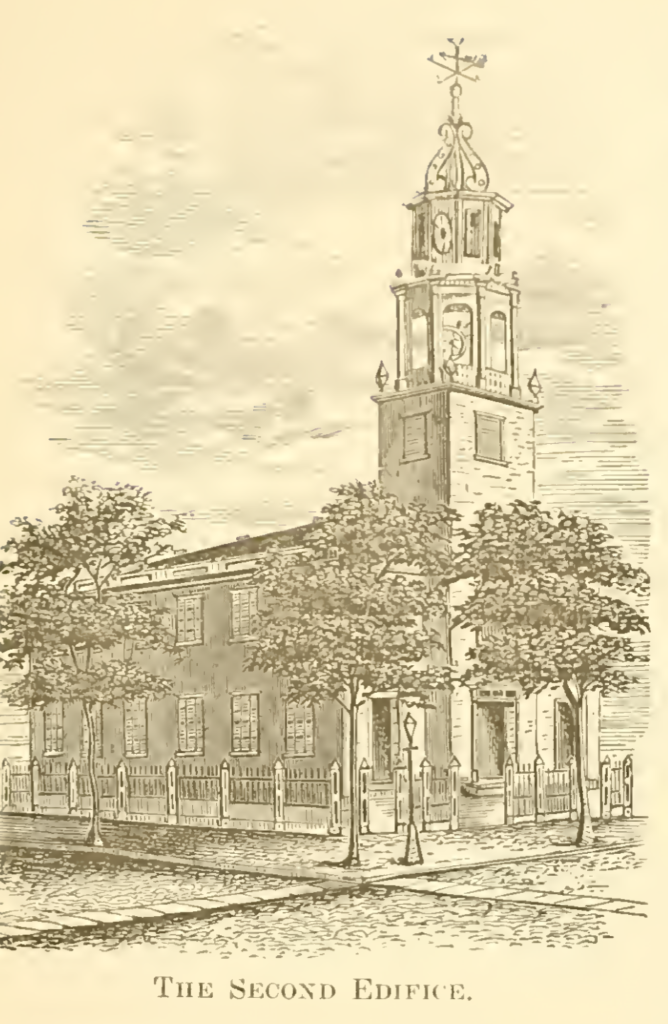
That building was enlarged and remodeled in 1831, as shown here. It remained the Presbyterian Church until 1850, when the congregation moved to another new church, this time at Philip and Hudson, just a block away from the church’s first location. The old (second) building became home to the Congregational Society for at least a few years.
The site of the second First Presbyterian church then became known as the Beaver Block (at least as early as 1869), and was used for businesses but also still hosted services, of the First Universalist Society. It seems likely the brick church was either torn down (“A Neat Modern Stile” reports it was razed circa 1890) or somehow incorporated into a much larger structure, because the Beaver Block, which housed many businesses and seems to have served as a union hall, was eventually a large structure spanning from Howard to Beaver.
Blayney sheds little light on the conversion, writing: “It then [1850] passed into the possession of the Congregational Society of this city, and was improved by them, till within a few years; when they removed to their new church on Eagle street. It was then sold, and has since been used for business purposes, and is now known as Beaver Block, on South Pearl street.”
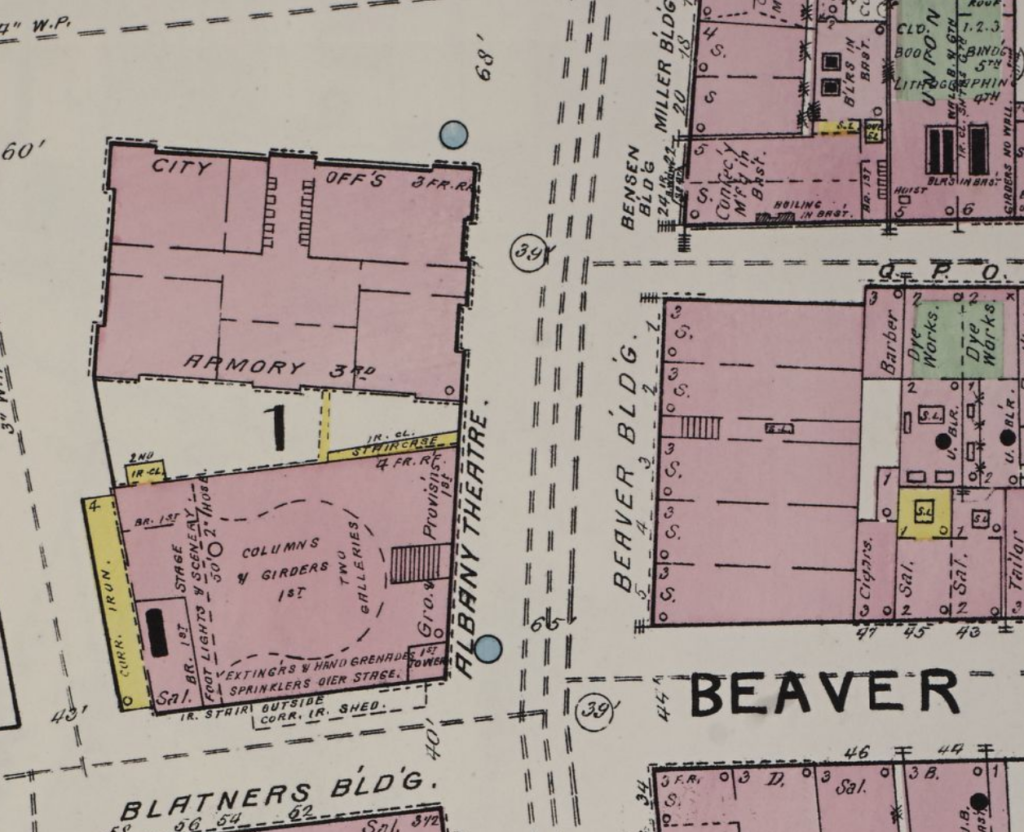
But try as we may, we do not find when the Beaver Block was finally demolished. This view of the block between Beaver and Norton, looking across South Pearl, shows nothing but parking:
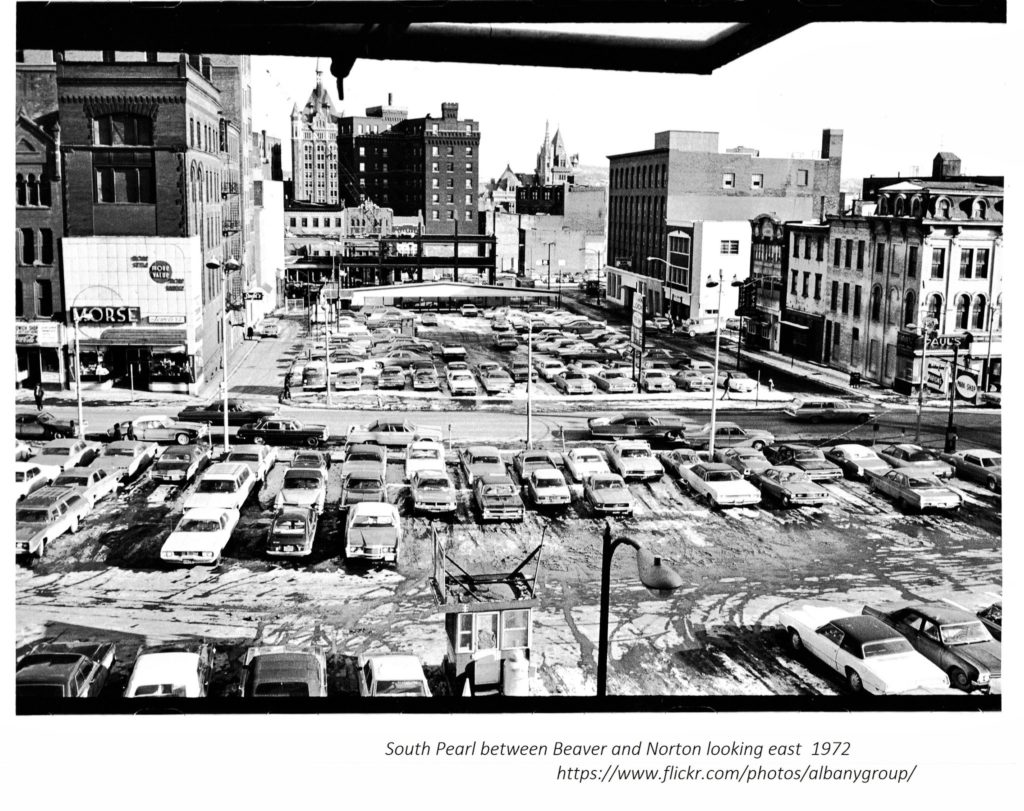
The third church building: Philip and Hudson
The third structure to house the First Presbyterian Church was a substantial structure located at Philip and Hudson, opening in March 1850, although it wasn’t considered completed (with the construction of a lecture room) until 1857. The front tower of the church was found to be dangerously settling in 1870, resulting in it being reconstructed and significant interior repairs made.
It was at this building that Susan B. Anthony found her woman’s suffragist groove in 1852. In that year she came to Albany as an elected delegate, along with several other women, to a state temperance convention. She rose to speak and was told that women were there merely to observe, not to speak. She and other women walked out, and she went to find her best friend Lydia Mott, who lived in Albany; Mott suggested she hold her own temperance meeting, just for women, and arranged for that meeting to be held at the First Presbyterian Church.
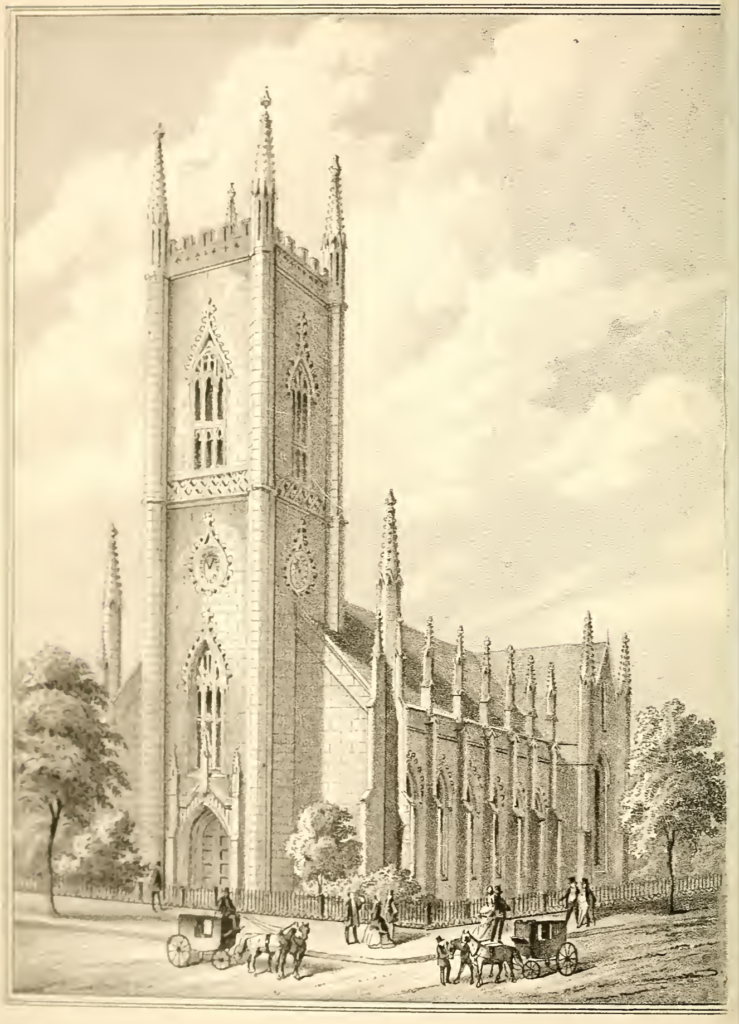
In 1884, the Presbyterians moved again, to the much tonier neighborhood Washington Park and the church that still stands at the corner of State and Willett, and this church became the Methodist Episcopal church; it was finally demolished around 1963-64 to make way for the South Mall, or the Empire State Plaza.
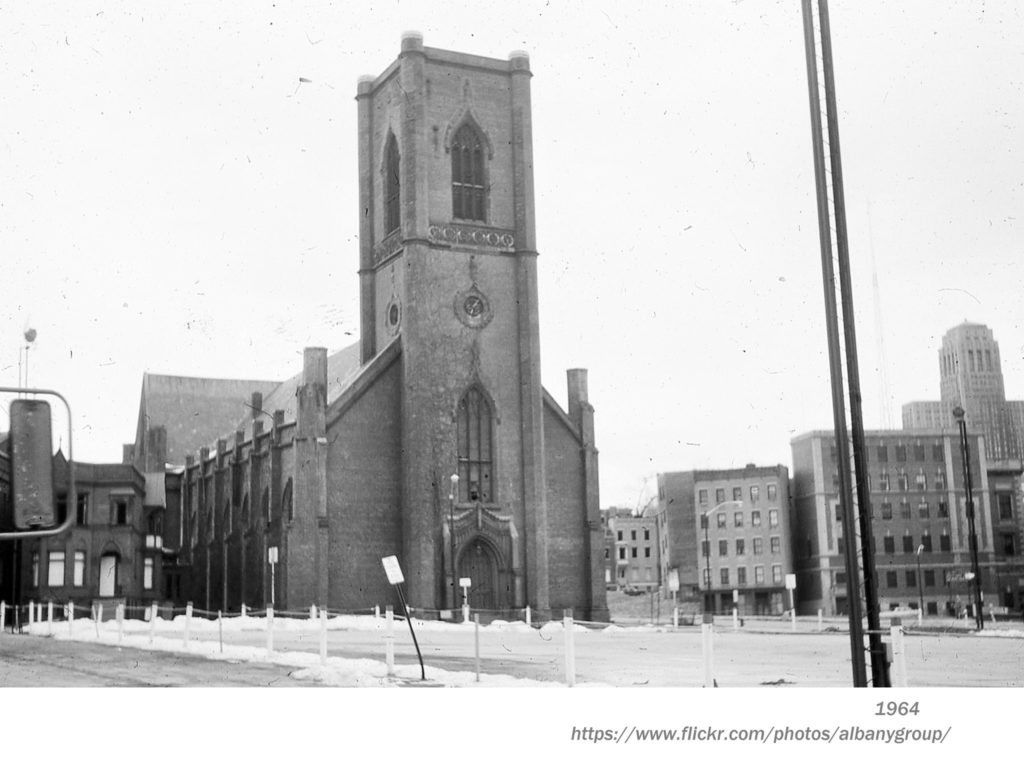
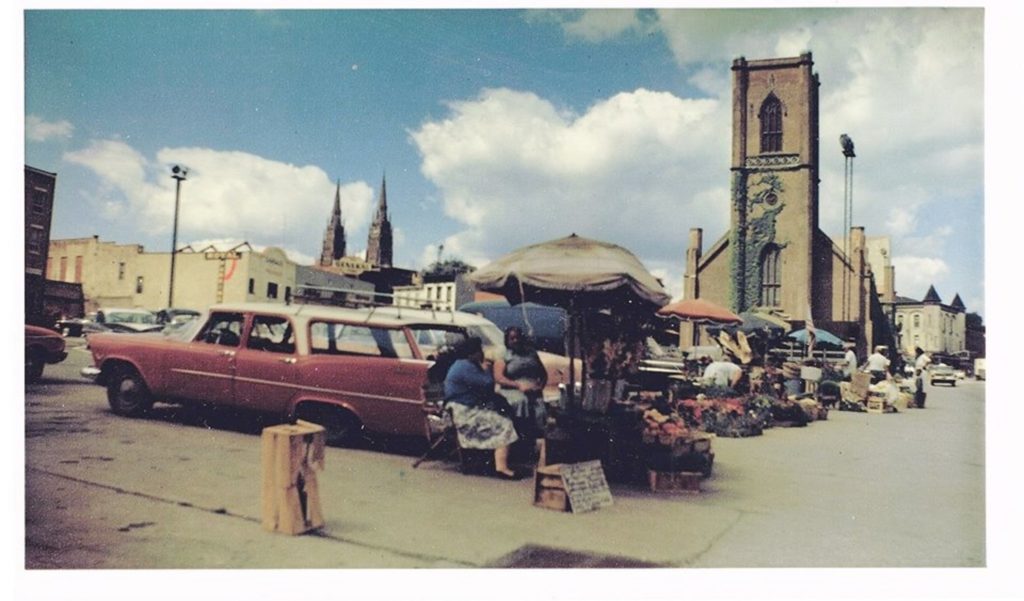

Did you ask the current First Presbyterian on State and Willet if they have the plaque? At Trinity UMC we have the cornerstone and another plaque from the first Methodist Church that was on Phillip street and was destroyed for the south mall. The congregations merged and we got their records and pictures and plaques!
Thanks, I didn’t ask, and it’s not impossible. I’ll see if I can find a contact there. I was familiar with the old cornerstone at Trinity, as my kids went to day care there!